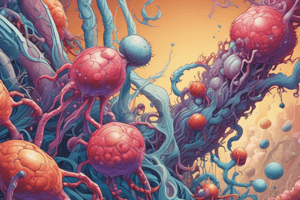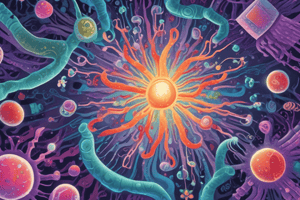Podcast
Questions and Answers
What happens if a patient stops taking antibiotics early?
What happens if a patient stops taking antibiotics early?
- All bacteria will be killed immediately.
- The antibiotic will still work effectively.
- Some bacteria may survive and become resistant. (correct)
- The patient will develop immunity to the antibiotic.
Taking all of the prescribed antibiotics ensures that all bacteria are killed.
Taking all of the prescribed antibiotics ensures that all bacteria are killed.
True (A)
What can happen to bacteria that survive antibiotic treatment?
What can happen to bacteria that survive antibiotic treatment?
They can become resistant to the antibiotic.
If bacteria become resistant, they may be passed on to another person, making antibiotic treatment ______.
If bacteria become resistant, they may be passed on to another person, making antibiotic treatment ______.
Match the outcome with its explanation regarding bacteria and antibiotics:
Match the outcome with its explanation regarding bacteria and antibiotics:
What is the main reason some bacteria become resistant to antibiotics?
What is the main reason some bacteria become resistant to antibiotics?
All bacteria will be killed by antibiotics regardless of their characteristics.
All bacteria will be killed by antibiotics regardless of their characteristics.
What theory explains how bacteria evolve to become resistant to antibiotics?
What theory explains how bacteria evolve to become resistant to antibiotics?
The process through which bacteria with beneficial traits survive and reproduce is called __________.
The process through which bacteria with beneficial traits survive and reproduce is called __________.
Match the type of selection with its description:
Match the type of selection with its description:
Which of the following correctly describes a type of variation among bacteria?
Which of the following correctly describes a type of variation among bacteria?
What impact does genetic drift have on small bacterial populations?
What impact does genetic drift have on small bacterial populations?
Which type of selection specifically involves traits that enhance survival and reproduction?
Which type of selection specifically involves traits that enhance survival and reproduction?
Genetic drift has a greater effect on large populations than on small populations.
Genetic drift has a greater effect on large populations than on small populations.
What is the primary consequence of the bottleneck effect in populations?
What is the primary consequence of the bottleneck effect in populations?
The ______ effect occurs when a small group of individuals starts a new population isolated from the original population.
The ______ effect occurs when a small group of individuals starts a new population isolated from the original population.
Match the effect with its description:
Match the effect with its description:
Which of the following best describes genetic drift?
Which of the following best describes genetic drift?
Natural selection is the only mechanism through which evolutionary change can occur.
Natural selection is the only mechanism through which evolutionary change can occur.
What is it called when traits that improve survival and reproduction accumulate in a population?
What is it called when traits that improve survival and reproduction accumulate in a population?
In studies of populations, ______ are more susceptible to genetic drift.
In studies of populations, ______ are more susceptible to genetic drift.
Which force of evolutionary change is linked to random chance events causing changes in allele frequencies?
Which force of evolutionary change is linked to random chance events causing changes in allele frequencies?
Flashcards
Survival characteristic
Survival characteristic
A characteristic that helps an organism survive and reproduce in its environment.
Evolution
Evolution
The process by which populations of organisms change over time due to differences in survival and reproduction.
Antibiotic resistance
Antibiotic resistance
The ability of bacteria to withstand the effects of antibiotics, meaning they are not killed by the medication.
Variation within a species
Variation within a species
Signup and view all the flashcards
Natural selection
Natural selection
Signup and view all the flashcards
Evolution of antibiotic-resistant bacteria
Evolution of antibiotic-resistant bacteria
Signup and view all the flashcards
Antibiotics and bacterial infections
Antibiotics and bacterial infections
Signup and view all the flashcards
Genetic Drift
Genetic Drift
Signup and view all the flashcards
Bottleneck Effect
Bottleneck Effect
Signup and view all the flashcards
Founder Effect
Founder Effect
Signup and view all the flashcards
Artificial Selection
Artificial Selection
Signup and view all the flashcards
Sexual Selection
Sexual Selection
Signup and view all the flashcards
Allele Frequency
Allele Frequency
Signup and view all the flashcards
Genetic Variation
Genetic Variation
Signup and view all the flashcards
Fitness
Fitness
Signup and view all the flashcards
What happens if you stop taking antibiotics early?
What happens if you stop taking antibiotics early?
Signup and view all the flashcards
How can antibiotic resistance spread?
How can antibiotic resistance spread?
Signup and view all the flashcards
How can antibiotics help and hurt?
How can antibiotics help and hurt?
Signup and view all the flashcards
What happens if you finish your antibiotic prescription?
What happens if you finish your antibiotic prescription?
Signup and view all the flashcards
How do bacteria become resistant to antibiotics?
How do bacteria become resistant to antibiotics?
Signup and view all the flashcards
Study Notes
Natural Selection: Antibacterial Resistance
- Bacteria like tuberculosis and pneumonia cause disease in humans.
- Antibiotics are used to kill bacteria, but some bacteria are resistant to them.
- Darwin's Theory of Evolution explains how resistant bacteria evolve:
- Variation exists in individuals within a species.
- Some individuals die before reproducing.
- Individuals with better survival traits reproduce more.
- Offspring inherit these traits, leading to more individuals with the best survival characteristics.
- Antibiotic treatment doesn't kill all bacteria.
- Surviving bacteria are resistant to the antibiotic.
- If treatment is stopped early, surviving bacteria multiply and become resistant.
- Resistant bacteria can be passed to others, making antibiotics ineffective in those individuals.
Types of Selection
- Natural Selection: Organisms with advantageous adaptations survive, reproduce, and pass on their genes.
- Artificial Selection: Humans select organisms with desirable traits for breeding, and these traits are passed down.
Sexual Selection
- Sexual Selection (a type of natural selection): Organisms with desirable traits (e.g., ornaments, behaviors) are more likely to survive, reproduce, and pass on their genes.
- Sexual Dimorphism: Differences in appearance between males and females of a species are often related to sexual selection. Females tend not to have exaggerated features because they are costly.
- Examples: Lion males with larger manes are often more attractive to females because this shows strength and health.
Other Forces of Evolutionary Change
- Genetic Drift: Random changes in gene frequencies within a population, especially prominent in small populations.
- Bottleneck Effect: A catastrophic event drastically reduces a population's size, leading to a loss of genetic diversity in the surviving population.
- Founder Effect: A small group of individuals leaves and starts a new population, with different allele frequencies than the original population.
- Gene Flow: Movement of genes between populations through immigration and mating.
Studying That Suits You
Use AI to generate personalized quizzes and flashcards to suit your learning preferences.
Related Documents
Description
Explore the critical concepts of antibiotic resistance and the evolution of bacteria in this quiz. Test your understanding of how early termination of antibiotics impacts bacterial survival and resistance. Delve into key biological theories and mechanisms that explain these phenomena.




